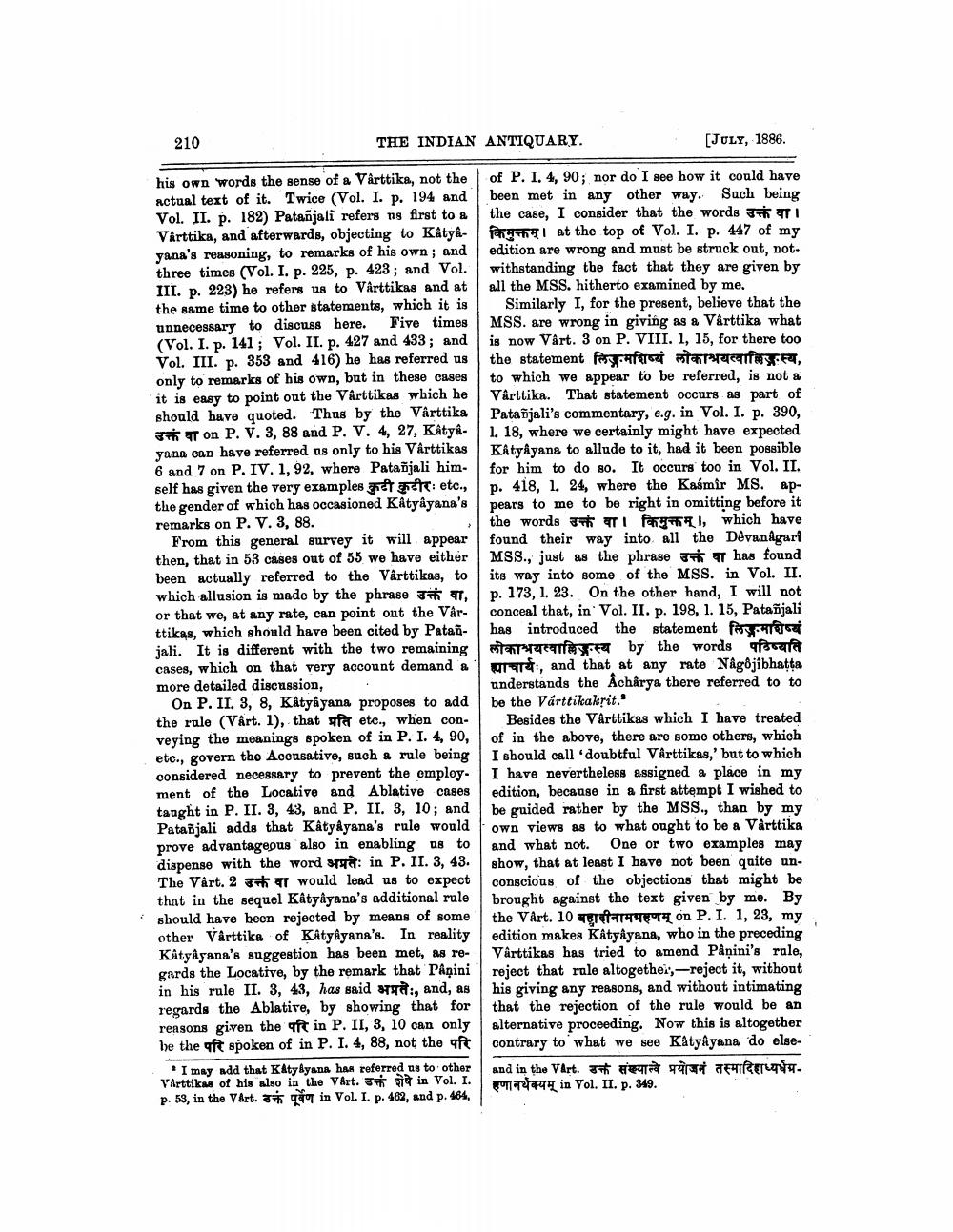________________
210
THE INDIAN ANTIQUARY.
[JULY, 1886.
his own words the sense of a Vårttika, not the of P. I. 4, 90; nor do I see how it could have actual text of it. Twice (Vol. I. p. 194 and been met in any other way. Such being Vol. II. p. 182) Patañjali refers ng first to the case, I consider that the words 3 TI Vårttika, and afterwards, objecting to Katya- Pal at the top of Vol. I. p. 447 of my yana's reasoning, to remarks of his own; and | edition are wrong and must be struck out, not. three times (Vol. I. p. 225, p. 423; and Vol. withstanding the fact that they are given by III. p. 223) he refers us to Vårttikas and at all the MSS. hitherto examined by me. the same time to other statements, which it is Similarly I, for the present, believe that the unnecessary to discuss here. Five times MSS. are wrong in giving as a Vârttika what (Vol. I. p. 141 ; Vol. II. p. 427 and 433; and is now Vârt. 3 on P. VIII. 1, 15, for there too Vol. III. p. 353 and 416) he has referred us the statement forfere wate r , only to remarks of his own, but in these cases to which we appear to be referred, is not a it is easy to point out the Vårttikas which he Vårttika. That statement occurs as part of should have quoted. Thus by the Vårttika Patañjali's commentary, e.g. in Vol. I. p. 390,
* T on P. V. 3, 88 and P. V. 4, 27, Katya- 1. 18, where we certainly might have expected yana can have referred us only to his Vårttikas Katyâyana to allude to it, had it been possible 6 and 7 on P. IV. 1, 92, where Patañjali him. for him to do so. It occurs too in Vol. II. self has given the very examples and are: etc., p. 418, 1, 24, where the Kasmir MS. apthe gender of which has occasioned KAtyâyana's pears to me to be right in omitting before it remarks on P. V. 3, 88.
the words उक्तं वा। किमुक्तम् ।, which have From this general survey it will appear found their way into all the Devanagari then, that in 53 cases out of 55 we have either MSS., just as the phrase a T has found been actually referred to the Vârttikas, to its way into some of the MSS. in Vol. II. which allusion is made by the phrase 3 , p. 173, 1. 23. On the other hand, I will not or that we, at any rate, can point out the Vår- conceal that, in Vol. II. p. 198, 1. 15, Patañjali ttikas, which should have been cited by Patañ- has introduced the statement for jali. It is different with the two remaining | लोकाश्रयत्वाल्लिजस्व by the words पठिष्यति cases, which on that very account demand a re , and that at any rate Någojibhatta more detailed discussion,
understands the Acharya there referred to to On P. II. 3, 8, Katyayana proposes to add be the Várttikakrit.' the rule (Vårt. 1), that of etc., when con- Besides the Vårttikas which I have treated veying the meanings spoken of in P. I. 4, 90, of in the above, there are some others, which etc., govern the Accusative, such a rule being I should call doubtful Vârttikas,' but to which considered necessary to prevent the omploy. I have nevertheless assigned & place in my ment of the Locative and Ablative cases edition, because in a first attempt I wished to taught in P. II. 3, 43, and P. II. 3, 10; and be guided rather by the MSS., than by my Patañjali adds that Kâtyâyana's rule would own views as to what ought to be a Vârttika prove advantageous also in enabling us to and what not. One or two examples may dispense with the word 8 : in P. II. 3, 43. show, that at least I have not been quite unThe Vârt. 2 at would lead us to expect conscious of the objections that might be that in the sequel Katyayana's additional rule
brought against the text given by me. By should have been rejected by means of some the Vårt. 10 THT on P. I. 1, 23, my other Vårttika of Kåtyâyana's. In reality edition makes Katyâyana, who in the preceding Katyayana's suggestion has been met, as re- Vârttikas has tried to amend Panini's role, gards the Locative, by the remark that Panini reject that rule altogethe', -reject it, without in his rule II. 3, 43, has said :, and, as his giving any reasons, and without intimating regards the Ablative, by showing that for that the rejection of the rule would be an reasons given the oft in P. II, 3, 10 can only alternative proceeding. Now this is altogether be the oft spoken of in P. I. 4, 88, not the oft
contrary to what we see Katyâyana do elgeI may add that Katy Byana has referred us to other and in the VArt. a RT ThreeVArttikas of his also in the Vart. 3 7 in Vol. I.
ET in Vol. II. p. 349. p. 58, in the Vårt. * a in Vol. I. p. 462, and p. 464,
scussion,




